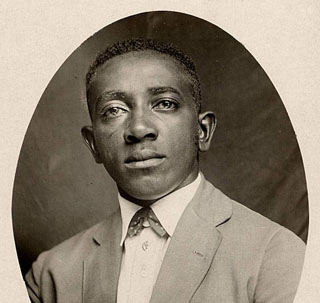

by Ravin St. Julien-Brown

At least once in many of our minds we have wondered who was the gentleman James A. Herod and why are schools honored in his name. Hopefully the following passage will answer that question that has been longing for an answer.
James A. Herod was a husband, father, preacher, and teacher. During his time here on earth when one heard the mention of his name, the following words came to mind . . . educated, passionate, activist, loving, loyal, honest, and religious.
Reverend James A. Herod was married to Josephine Robinson of Abbeville. She was the daughter of James Robinson and Rose Joiner. He was listed in the 1900 Federal Census of Vermilion Parish as born in November of 1860 in Tennessee. Rev. Herod was forty years old and she was thirty-two years old at the time the census was composed. He was sent to Louisiana by the American Missionary Association to attend Straight College and New Orleans University which are now Dillard University in New Orleans.
Home of Rev. James A. Herod
601 St. Victor Street
Abbeville, Louisiana
When he first entered Louisiana in the late 1800's which was the turn of the century, slavery had been abolished and the south was slowly transforming into a new south. However there was still one hurdle the Reverend had to face and his name was Jim Crow. From the 1800's into the 1960's a majority of the states enforced segregation through “Jim Crow’s” laws. These laws governed nearly every aspect of daily life, from education to public transportation. Each state had various Jim Crow laws; for example, Louisiana had laws that stated:
1868: Prohibited separate schools based on race
1898: General Assembly to establish free public schools for the white and colored races
1921: Called for separate, free public schools for the education of white and black children between the ages of six and eighteen years
1954: Immediately after the Brown’s decision, Louisiana amended its Constitution to state that all public and elementary schools would be operated separately for white and black children. Penalty: $500 to $1,000 for not enforcing and imprisonment from three to six months.
1957: Compulsory attendance suspended in school systems where integration ordered; no state funds to non-segregated schools
Rev. James A. Herod was a good citizen and even though he knew in his heart that the laws of the land were unfair, in no manner would he break those laws. Instead he decided to act in a nonviolent legal way. He promised himself he would make sure the African-American children of Abbeville would receive equal or better education just as the other children within the community had access to. He and his wife were very educated and decided to immediately start teaching.
St. Mary Congregational Church
213 S. Louisiana Avenue
Abbeville, Louisiana
The first building he used to teach in was St. Mary Congregational Church. Building a school was very costly and a majority of the community was poor, so he used his second home (St. Mary) as a school. Even though his main focus was education for the youth of the community he didn’t stop with reading and arithmetic; he also taught the word of the Bible to the elders of the town.
Cornerstone of
St. Mary Congregational Church
In the archives of St. Mary Congregational Church it is noted, Rev. Herod was the second pastor of St. Mary Congregational Church. He served as pastor of the church for thirteen years and was the serving pastor when the sanctuary was built in 1905. While serving as pastor, he helped organize a Sunday School program, Vocational Bible School, and many other committees for the church. Even though the Reverend had one leg and had to use what was called a “Peg-Leg,” he still was very mobile and inspired the people of the community to mobilize and become active within the community.
State historic marker
honoring St. Mary and
Rev. James A. Herod
As time passed, his focus grew on a broader image—instead of concentrating solely on the city of Abbeville, he and his wife shared their time, knowledge, and wisdom throughout the entire Vermilion Parish. Rev. Herod was very interested in educational, religious, and civic affairs of Vermilion Parish. He was a member of the Board of Directors for the city Chamber of Commerce.
The first school that was blessed with his name was located on Lampman Street which is now known as Dr. Martin Luther King Drive. The school was located in the heart of the African-American community. The location of the school made it easy for students to have access to a good education without traveling far.
Later the school was demolished and replaced on the same property with a new and improved school. It was also much bigger. In 1955 the new school was opened and named in his honor, "Herod High School"; it was the first and last African-American school of Abbeville and taught a curriculum that covered 1st through 12th grades. Later, in 1969-1970, the high school was closed due to the end of segregation and reopened in the 80's as an elementary school that covered the grades of 4th and 5th and eventually was closed permanently. The old East Abbeville Elementary located at 120 Odea Street was renamed in 1991 after the Honorable Reverend James A. Herod.
James A. Herod
Elementary School
120 Odea Street
Abbeville, Louisiana
Even though the original James A. Herod High school is no longer open, his name still rings loudly within the community. He is acknowledged as the father of African-American education of Abbeville. Many generations of African-American families received quality education thanks to Reverend Herod. Before he made his contribution to the community, a majority of the African-American citizens were illiterate and were unable to spell or to write their names—they would sign documents with the letter “x” as their signature. If he were still with us today he would be humbled and honored to know that not only are African-Americans receiving quality educations in a school named after him, but ALL kids are legally allowed to sit together and receive the proper education needed to become hopefully one day a leader, just as he was.
The Reverend James A. Herod was laid to rest in the Congregational Church Cemetery on Prairie Avenue in 1948.
By
Ravin St. Julien-Brown
Comment by Robert F. Guilbeaux, Jr.: Thank you for this inspirational story. However, James Herod School serviced as the High School for all negro students in Vermilion Parish not just Abbeville. I recall my mother telling stories of the bus ride from Gueydan to Abbeville. I think this is worthy of mentioning.